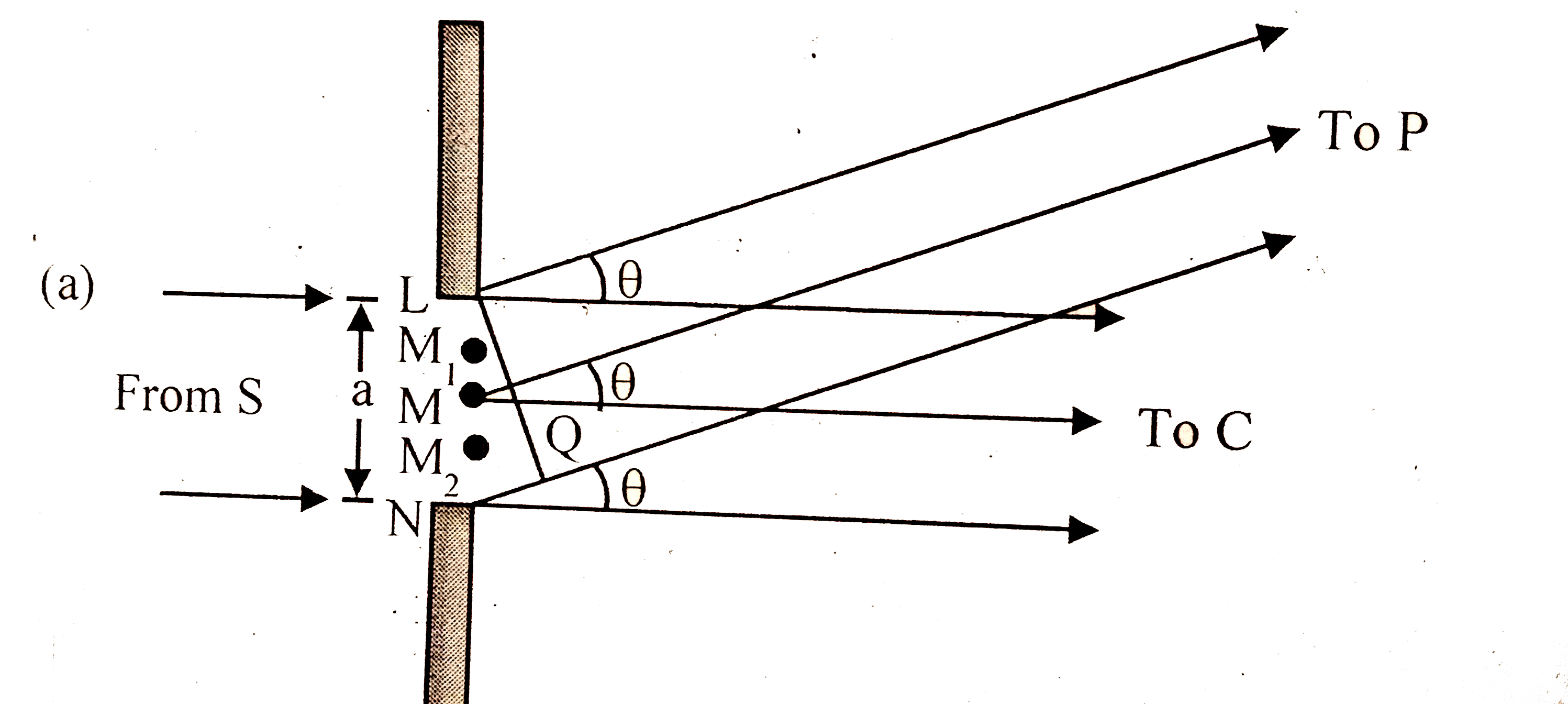(a) Derive the relation a sinθ=λ for the first minimum of the diffraction pattern produced due to a single slit of width ‘a’ using light of wavelengthλ.
(b) State with reason, how the linear width of central maximum will be affected if
(i) monochromatic yellow light is replaced with red light, and
(ii) distance between the slit and the screen is increased.
(c) Using the monochromatic light of same wavelength in the experimental set-up of the diffraction pattern as
well as in the interference pattern where the slit separation is 1 mm, 10 interference fringes are found to be within the central maximum of the diffraction pattern. Determine the width of the single slit, if the screen is kept at the same distance from the slit in the two cases.

From diagram path difference between the waves from L and N =asinθ
When first minimum is obtained at P, then path difference =λ
Wavelets from first half of the slit has a corresponding wavelet from second half of the slit differing by a path of λ2 and cancel each other ]
Condition for first minimum -
λ=asinθ
(b) We know that βcm=2λDd
(i) increases , (ii) increases
(c) 10λd=2λa
Or a=d5=0.2mm
Topper's Solved these Questions
Similar Questions
(a) Derive the relation asinθ=λ for the first minimum of the diffraction pattern produced due to a single-slit of width 'a' using light of wavelength λ.
(b) State with reason, how the linear width of central maximum will be affected if (i) monochromatic yellow light is replaced with red light, and (ii) distance between the slit and the screen is increased.
(c) using the monochromatic light of same wavelength in the experimental set-up of the diffraction pattern as well as in the interference pattern where the slit separation is 1mm, 10 interference fringes are found to be within the central maximum of the diffraction pattern. determine the width of the single-slit, if the screen is kept at the same distance from the slit in the two cases.
View SolutionIn a single slit diffraction of light of wavelength λ by a slit of width e, the size of the central maximum on a screen at a distance b is
View Solution
Knowledge Check
In the diffraction pattern due to a single slit of width 'd' with incident light of wavelength 'λ', at an angle of diffraction 'θ', the condition for first minimum is
Aλsinθ=dBdcosθ=λCdsinθ=λDλcosθ=dThe first minimum of a single slit diffraction pattern is observed at angle 2∘ with a light of wavelength 698 nm. The width of this slit is
A2 mmB0.2 mmC0.02 mmD0.002 mmIn a single slit diffraction of light of wavelength λ by a slit of width e, the size of the central maximum on a screen at a distance b is
A(a) 2bλ+eB(b) 2bλeC(c) 2bλe=eD(d) 2bλe−e
In a single slit diffraction pattern, how is the angular width of central bright maximum changed when (i) the slit width is decreased.
(ii) the distance between the slit and screen is increased.
(iii) Light of smaller wavelength is used. Justify your answer.
View SolutionIn a single slit diffraction pattern, how is the angular width of central bright maximum changed when (i) the slit width is decreased.
(ii) the distance between the slit and screen is increased.
(iii) Light of smaller wavelength is used. Justify your answer.
View SolutionIn a single-slit diffraction pattern, how does the angular width of central maximum change, when
(i) slit width is decreased,
(ii) distance between the slit and screen is increased, and
(iii) light of smaller visible wavelength is used ?
Justify your answer in each case.
View SolutionFirst diffraction minima due to a single slit of width 10−4cm is at θ=30∘. The wavelength of the light used is –
View SolutionFirst diffraction minima due to a single slit of width 10−4cm is at θ=30∘. The wavelength of the light used is –
View Solution
